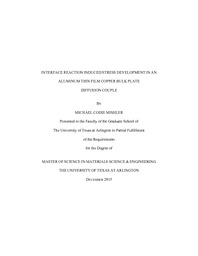| dc.contributor.advisor | Kim, Choong-Un | |
| dc.creator | Mishler, Michael Codie | |
| dc.date.accessioned | 2016-01-27T00:10:40Z | |
| dc.date.available | 2016-01-27T00:10:40Z | |
| dc.date.created | 2015-12 | |
| dc.date.issued | 2015-12-18 | |
| dc.date.submitted | December 2015 | |
| dc.identifier.uri | http://hdl.handle.net/10106/25474 | |
| dc.description.abstract | This thesis investigates the mechanism of the interface reaction induced intermetallic phase formation (IMC) and its impact on the interface reliability in Al-Cu diffusion couple pairing. This study is motivated by the accelerated failure experiments in lead frame to integrated circuit (IC) package wire-bonds using copper (Cu) wire and aluminum (Al) bond-pad that have shown failure most often occurs at the interface of the intermetallic compound (IMC) γ2-phase (Cu9Al4).
In order for simulative investigation, we created a diffusion couple consisting of Cu bulk plate coated pure Al thin films with thickness of ~2µm. This configuration is adapted to resemble the microstructural configuration in a Cu wire Al bond pad. In this wirebond, the pad is made of Al thin film, while the Cu wire has the microstructure state closer to that of a bulk. The typical wirebond process melts then solidifies the tip of the wire onto the bond pad. In addition, we introduce two types of Cu plate as our samples, namely half-hard and fully annealed Cu plate. These samples are introduced in order to investigate the effect of microstructure, such as dislocation and grain boundaries and also residual stress on the interface reaction kinetics.
Our experiment of Al thin film on bulk Cu has shown that the interface reaction creates a tensile stress in the Cu lattice. The stress generation is found to be closely associated with the formation of γ2-phase. The stress is generated due to the formation of γ2-phase, which remains cohesively attached to the Cu lattice, expanding the Cu as it grows. The expected initial formation of θ-phase (CuAl2) is never seen in our experiment as has been reported in thin-film / thin-film (TF/TF) and bulk / bulk (B/B) infinite diffusion couples. While the principle mechanism of stress generation in Cu plate with the IMC formation remains the same for both half-hard and fully annealed Cu plate, X-ray diffraction data collected on aged samples revealed that the rate of IMC formation and thus the stress generation is smaller in half-hard Cu. This is the opposite of what is expected. The presence of finer grains and high dislocation density should promote short-circuit diffusion making the diffusion of Cu into Al faster. It is our conclusion that the enhancement in the short-circuit diffusion is outweighed by a suppression of diffusion by compressive residual stress. Half-hard Cu plate is expected to have compressive residual stress and therefore likely to contain lower equilibrium concentration of vacancies.
Our results of the stress generation during γ2-phase formation and the suppression of diffusion in compressively strained lattices explains why it has been observed that IMC formation occurs first near the outer edges of the wire-bonds. The wire-bonding process creates a work hardened condition towards the center of the wire-bond, slowing IMC formation. The interface stress created by γ2-phase formation expanding the Cu lattice presents favorable conditions for crack nucleation which has been observed in Cu-Al wire-bond failure. | |
| dc.format.mimetype | application/pdf | |
| dc.language.iso | en_US | |
| dc.subject | Cu-Al intermetallic compound | |
| dc.subject | IMC | |
| dc.subject | Thin films | |
| dc.subject | Bulk diffusion couple | |
| dc.subject | Reaction induced diffusion | |
| dc.subject | Interface stress | |
| dc.title | INTERFACE REACTION INDUCED STRESS DEVELOPMENT IN AN ALUMINUM THIN FILM COPPER BULK PLATE DIFFUSION COUPLE | |
| dc.type | Thesis | |
| dc.date.updated | 2016-01-27T00:10:40Z | |
| thesis.degree.department | Materials Science and Engineering | |
| thesis.degree.grantor | The University of Texas at Arlington | |
| thesis.degree.level | Masters | |
| thesis.degree.name | Master of Science in Materials Science and Engineering | |
| dc.type.material | text | |

